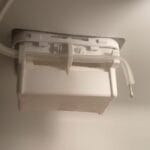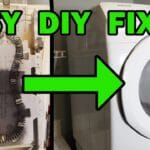Water damaged particle board cabinets can be a homeowner’s nightmare. You might feel overwhelmed by the sight of swollen wood and peeling surfaces.
But don’t worry—there’s a way to bring your cabinets back to life. Imagine the satisfaction of restoring your cabinets to their original glory without spending a fortune on replacements. You’ll not only save money, but also learn a valuable skill that can keep your kitchen looking its best.
In this guide, you’ll discover practical, step-by-step solutions to fix your water damaged particle board cabinets. Whether the damage is minor or severe, you’ll find easy-to-follow tips that will make the repair process straightforward and stress-free. By the end of this article, you’ll have the confidence and know-how to tackle this common issue head-on. So, let’s dive in and transform your kitchen cabinets from drab to fab!

Credit: www.tiktok.com
Identifying Damage
Identifying damage in water-damaged particle board cabinets is crucial. Recognizing early signs can prevent further deterioration. It saves time and money in repairs. Water exposure can cause various issues. Knowing what to look for helps in fixing the problem efficiently.
Signs Of Water Damage
Water damage can manifest in different ways. Look for swelling or puffiness in the particle board. Discoloration is another indicator. Dark spots or stains often appear. Check for musty odors. They suggest mold growth. Observe any peeling or bubbling on the surface. These are clear signs of water exposure.
Assessing The Extent
Determine how severe the damage is. Examine the affected areas closely. Tap the surface gently. Listen for hollow sounds. They indicate compromised structure. Check for softness or sponginess. Press the surface lightly. It should feel firm. If it’s soft, damage is significant. Measure the affected area. Larger areas may need professional help.
Use a flashlight for dark spaces. Shine it on the cabinet’s interior. Look for hidden damage. Any cracks or warping need attention. Assessing damage accurately helps decide the repair approach.
Drying Out Cabinets
Water damage to particle board cabinets can be a real headache. Drying them thoroughly is crucial to prevent mold and further damage. Let’s explore effective ways to dry them out.
Using Fans And Dehumidifiers
Fans are excellent for drying cabinets. Place a fan near the cabinet. Turn it on to blow air directly onto the damp areas. This speeds up evaporation. Use a dehumidifier alongside the fan. It helps remove moisture from the air. Keep the room closed to enhance its efficiency. This combination works well, especially in humid environments.
Natural Air Drying Methods
Natural air drying is another effective method. Open windows and doors to let fresh air circulate. Sunlight can also aid drying. It helps reduce moisture naturally. Ensure the cabinet doors are open wide. This maximizes air flow inside. It’s a simple, eco-friendly option. Perfect for those without equipment.
Removing Damaged Sections
Water damage in particle board cabinets is a common issue. Removing damaged sections is crucial for repair. It helps restore the cabinet’s functionality and appearance. This step involves cutting away swollen areas and sanding rough edges. Each action ensures the cabinet’s surface is smooth and ready for further treatment.
Cutting Away Swollen Areas
Swollen areas indicate severe water damage. Use a utility knife or a saw for this task. Carefully cut along the swollen section’s edges. Ensure you remove only the damaged part. This minimizes waste and retains the cabinet’s structure. Wear safety goggles to protect your eyes during cutting.
Sanding Rough Edges
After cutting, rough edges remain. Sanding smooths these edges. Use medium-grit sandpaper for best results. Sand in a circular motion for evenness. This process prepares the surface for refinishing or repair. Ensure the area is smooth to the touch after sanding. A smooth surface improves the cabinet’s appearance and durability.

Credit: www.pinterest.com
Reinforcing Structure
Fixing water-damaged particle board cabinets involves assessing damage and removing affected parts. Apply wood filler to fill gaps, then sand surfaces for smoothness. Seal repaired areas with waterproof paint or varnish to prevent future damage and enhance durability.
Reinforcing the structure of water-damaged particle board cabinets is crucial to restore their functionality and extend their lifespan. If your cabinets are sagging or feel unstable, it’s time to take action. You can fix this issue by reinforcing their structure with simple, effective methods.Installing Support Braces
Support braces can significantly enhance the sturdiness of your particle board cabinets. Begin by measuring the areas that need extra support. Cut wooden braces to fit these dimensions precisely. Secure the braces by screwing them into the most stressed parts of the cabinet. Focus on the corners and any sagging shelves. This step will help distribute weight more evenly, preventing further damage. While installing, ensure the braces are tightly fitted and level. This prevents any wobbling and ensures durability. You might be surprised by how much stability a few pieces of wood can add.Applying Wood Glue
Wood glue is a powerful ally in reinforcing your cabinets. It can fill gaps and strengthen weakened joints. Select a high-quality wood glue for the best results. Apply the glue to any loose or damaged parts. Use a small brush for precision, ensuring the glue penetrates deeply into the cracks. Once applied, press the pieces together firmly. Allow the glue to dry completely before using the cabinet again. This ensures the strongest bond. What’s your go-to method for fixing things around the house? Sometimes, a simple approach like using wood glue can save the day and money. Reinforcing your cabinets may seem daunting, but with these steps, you can tackle the task effectively. Remember, addressing the problem sooner rather than later can save you from more significant repairs down the road.Sealing And Protecting
Water damage can ruin particle board cabinets. To prevent further damage, sealing and protecting them is essential. This process not only safeguards the cabinets but also extends their lifespan. Proper sealing keeps moisture at bay, preserving the cabinet’s integrity and appearance. Let’s explore effective methods to seal and protect your particle board cabinets.
Applying Water-resistant Coating
Start by cleaning the cabinet surfaces. Remove dust and grease with a mild cleanser. This ensures the coating adheres well. Once clean, select a water-resistant coating. Polyurethane is a popular choice. It forms a durable, protective layer. Apply with a brush or roller in thin, even coats. Allow it to dry completely before applying additional layers. Two to three coats provide optimal protection.
Using Sealant Products
Sealant products offer another layer of defense. They fill gaps and cracks, preventing water infiltration. Choose a sealant designed for wood surfaces. Silicone-based sealants work well for particle board. Apply the sealant along edges, seams, and corners. This ensures all vulnerable areas are covered. Use a caulking gun for precise application. Smooth the sealant with a damp finger or tool. Allow it to cure completely for maximum effectiveness.

Credit: www.youtube.com
Replacing Hardware
Fixing water damaged particle board cabinets involves removing the damaged parts and replacing them with new material. Ensure the new pieces fit perfectly and secure them with waterproof adhesive. Finally, apply a protective finish to prevent future damage.
Replacing hardware on your water-damaged particle board cabinets can breathe new life into your kitchen or bathroom. It’s a simple yet effective way to refresh the look and function without breaking the bank. With the right tools and a bit of patience, you can achieve a stylish transformation that leaves your cabinets looking as good as new.Installing New Hinges
Swapping out old hinges can dramatically enhance the movement and alignment of cabinet doors. First, ensure you have the correct size and type of hinge that matches your cabinet’s style. Consider soft-close hinges for a modern touch that prevents door slamming. Remove the old hinges carefully using a screwdriver, taking note of the placement to align the new ones correctly. Align the new hinges with the pre-existing holes, or drill new ones if necessary. Secure them firmly to ensure the doors hang straight and close smoothly. Don’t rush this process; a precise installation will prevent future door misalignments.Upgrading Handles And Knobs
Handles and knobs are the jewelry of your cabinets, offering both function and flair. Select pieces that complement your cabinet’s color and overall room design. Mix and match styles for a unique look or stick to uniform pieces for a classic appeal. Remove the old handles or knobs using a screwdriver. Align the new hardware with the existing holes, or drill new ones for a fresh placement. Ensure they are tightly screwed in for durability and ease of use. Personal experience shows that upgrading hardware can change the room’s vibe entirely. What style will you choose to express your personality? Remember, small changes can make a big impact, so choose wisely and enjoy the transformation!Preventative Measures
Preventing water damage to particle board cabinets saves money and frustration. Regular upkeep and protective actions help cabinets last longer. These measures are easy and effective.
Regular Maintenance Tips
Check cabinets for water leaks monthly. Look under the sink for dampness or stains. Fix any leaks immediately to prevent damage.
Clean cabinets with a damp cloth, not soaking wet. Use mild soap for stubborn dirt. Dry them thoroughly after cleaning.
Protecting Against Future Damage
Apply water-resistant sealant to cabinet surfaces. This adds a protective layer against moisture. Sealant should be reapplied every few years.
Consider adding a waterproof mat under sink cabinets. This catches any accidental spills or leaks. It helps protect the base of your cabinets.
Frequently Asked Questions
How Do You Identify Water Damage In Particle Board?
Check for swelling or discoloration. Soft spots indicate moisture absorption. These signs suggest water damage in cabinets.
Can Water Damaged Particle Board Be Repaired?
Yes, it can. Dry the board completely first. Then, sand, patch, and seal affected areas to fix damage.
What Tools Are Needed For Fixing Cabinets?
You’ll need a sander, wood filler, sealant, and paint. These tools help restore the cabinet’s look and function.
How Long Does Cabinet Repair Take?
Repair time varies. Small fixes might take hours. Larger repairs can take a few days to complete.
Is Replacing Particle Board Better Than Repairing?
Replacement costs more. Repair is often cheaper and quicker. Consider replacement for severe damage or structural issues.
Conclusion
Fixing water damaged particle board cabinets is doable with patience. Start by assessing the damage. Dry the affected area thoroughly. Replace severely damaged parts. Consider sealing the board to prevent future issues. Use appropriate tools and materials for a better finish.
Regular maintenance keeps cabinets looking fresh. Keep your kitchen dry to avoid damage. Remember, small repairs prevent bigger problems. With these steps, your cabinets can last longer. Stay proactive and enjoy a clean, functional kitchen space. Your efforts will be worth it in the end.
Happy repairing!




